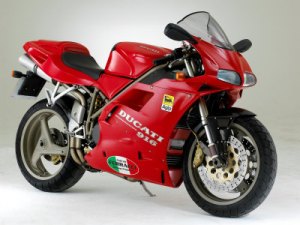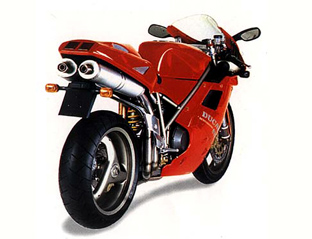 When it comes to bringing technological innovation to mass produced motorcycles, Yamaha leads the way with its revolutionary GTS 1000. The GTS was the first mass production Superbike of the present age to use a front suspension system that didn’t employ a couple of telescopic forks and a chassis that doesn’t run more or less in a straight line from the steering head to the swingarm pivot.
When it comes to bringing technological innovation to mass produced motorcycles, Yamaha leads the way with its revolutionary GTS 1000. The GTS was the first mass production Superbike of the present age to use a front suspension system that didn’t employ a couple of telescopic forks and a chassis that doesn’t run more or less in a straight line from the steering head to the swingarm pivot.
Motorcycle manufactures have long searched for a method of suspending the front wheel of a motorcycle that doesn’t rely on conventional telescopic forks. ‘Teles’ are unsatisfactory for several reason, they are prone to flexing under braking and when corning, and then cause the front end of the bike to ‘dive’ under braking. The search for a realistic alternative has been the Holy Grail of motorcycle engineering.
Yamaha’s alternative front end, as featured on the GTS 1000, in a solitary sided front swingarm with hub-centre navigating not unlike one front wheel of a car. Separating the steering purpose from the suspension should, in theory, produce a bike that steers, corners and brakes better than a bike with conventional forks.
The GTS’s Omega chassis is different from that of a conventional bike because the front suspension removes the necessity for a headstock. The aluminium alloy frame is a squat box shaped affair which wraps around the engine, on to which are bolted the front and rear suspension systems, as well as the sub-frames necessary for the steering, seat and bodywork.
The result is a bike that has most sophisticated front suspension systems in production. The bad news is that, in the case of the GTS at least, this kind of suspension system offers no significant improvement over conventional telescopic forks. Being designed as a sports touring motorcycle the GTS is too long and carries too much weight to reap any benefits from the hub-centre steering other than the elimination of the front end drive under braking.
Filed under: Yamaha | Tagged: bike, bodywork, GTS 1000, headstock, Holy Grail, motorcycle, Omega Chassis, sports, steering, Superbike, Telescopic forks, Yamaha | Leave a comment »





